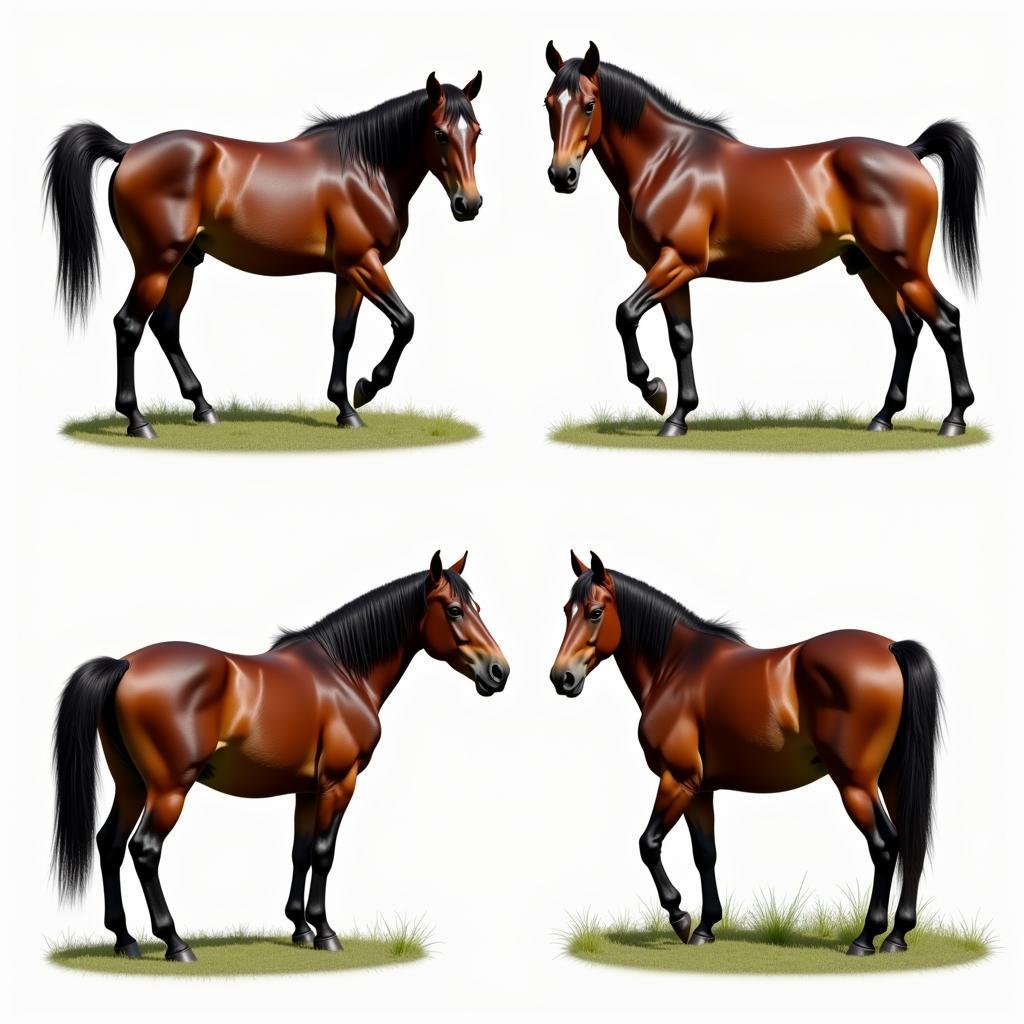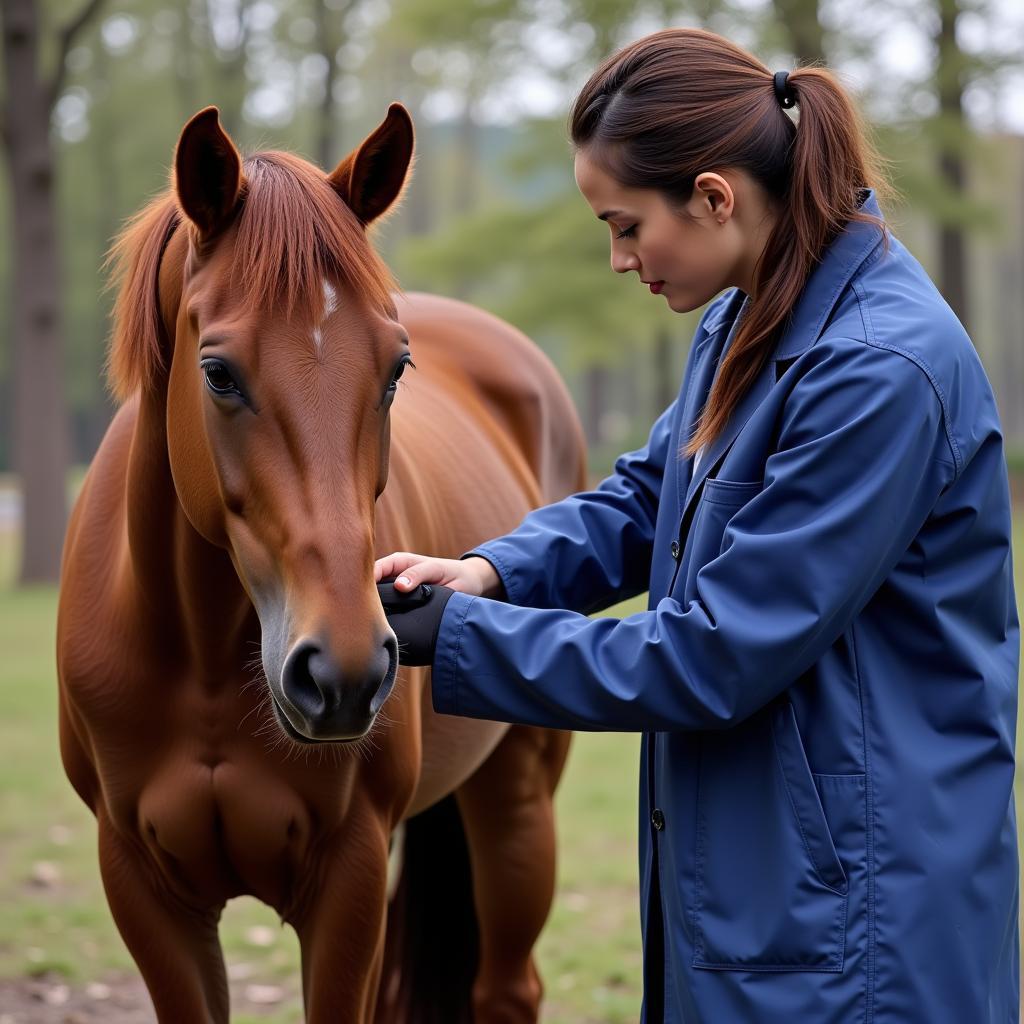Horses are majestic creatures, but unlike our canine companions, their communication skills are a little more nuanced. You might be wondering, “Do Horses Wag Their Tails like dogs?” The answer is both yes and no. While horses do swish their tails, it doesn’t always signal happiness. Let’s delve deeper into the fascinating world of equine body language and unravel the mysteries behind a horse’s tail movements.
The Tail Tells a Tale: Understanding Horse Communication
Horses primarily communicate through body language, and their tails play a crucial role in conveying their emotions and physical state. Unlike dogs, who wag their tails to express joy, horses use their tails to express a broader range of feelings, from contentment to irritation to even potential health issues.
Why Do Horses Swish Their Tails?
1. Shooing Away Pests: One of the most common reasons for tail swishing is simply to swat away pesky flies and insects. This is especially prevalent during warmer months or in areas with high insect populations.
2. Expressing Discomfort or Irritation: A horse might swish its tail rapidly from side to side if it’s feeling irritated, frustrated, or uncomfortable. This could be due to various factors like an ill-fitting saddle, an annoying fly they can’t reach, or even boredom.
3. Signaling Anxiety or Fear: In moments of anxiety or fear, a horse’s tail might become clamped down tightly or tucked between its hindquarters. This instinctive response is often accompanied by other signs of distress, such as flared nostrils, wide eyes, and tense muscles.
 Horse Swishing Tail
Horse Swishing Tail
Beyond the Swish: Other Tail Signals
1. The Gentle Sway: A slow, rhythmic swaying of the tail, often seen when a horse is relaxed and content, can indicate a state of well-being.
2. The Playful Whack: Young horses, or those feeling particularly playful, might engage in tail-flagging, where they hold their tails high and swish them enthusiastically. It’s their way of letting off steam and can be a sign of excitement.
3. The Warning Sign: A high, stiff tail, especially when paired with pinned ears and a raised head, is a clear warning signal. The horse is communicating a threat and might be preparing to kick or bite.
 Horse Tail Positions
Horse Tail Positions
Can You Tell a Horse’s Mood by Its Tail?
While tail movements offer valuable insights into a horse’s emotional state, it’s crucial to remember that relying solely on tail language can be misleading. Always consider the horse’s overall body language, including ear position, facial expressions, and overall posture, for a more accurate interpretation.
For instance, a horse swishing its tail gently while grazing in a field is likely content. However, a horse swishing its tail rapidly while pinning its ears back might be signaling agitation or aggression.
When to Seek Expert Advice
If you notice any sudden or drastic changes in your horse’s tail movements, especially if accompanied by other behavioral or physical changes, it’s essential to consult a veterinarian. Unexplained tail swishing could indicate underlying health issues that require professional attention.
 Veterinarian Examining Horse's Tail
Veterinarian Examining Horse's Tail
Conclusion
Deciphering the language of a horse’s tail is an integral part of understanding these magnificent animals. By paying attention to their subtle cues and learning to interpret their body language, we can build stronger bonds and ensure their well-being. Remember, while a wagging tail in a dog might signify happiness, a swishing tail in a horse tells a far more complex story.
Do you want to learn more about caring for your equine companion? Explore our website for a wealth of information on horse care, training, and more!
FAQs
1. Do all horses swish their tails the same way?
No, just like individual personalities, horses have their unique ways of communicating. Some might swish their tails more frequently or vigorously than others, even in similar situations.
2. Can a horse injure itself by swishing its tail?
While generally harmless, excessive tail swishing can lead to tail rubbing and hair loss. If you notice your horse excessively rubbing its tail, consult a veterinarian to rule out any underlying medical conditions.
3. Should I be worried if my horse never swishes its tail?
Not necessarily. Some horses are naturally less expressive with their tails. However, if you notice a sudden absence of tail movement in a horse that usually swishes its tail, it’s worth observing for any other signs of illness or discomfort.
4. Can I train my horse to stop swishing its tail?
Attempting to suppress natural behaviors like tail swishing is not recommended. Instead, focus on understanding the underlying reason for the behavior and address any potential sources of discomfort or stress.
5. Are there any specific tail movements that indicate colic?
While a horse experiencing colic might exhibit various signs like pawing the ground, rolling, or flank-watching, tail swishing alone isn’t a reliable indicator of colic. If you suspect your horse might be colicking, contact your veterinarian immediately.
Need Help? We’re Here for You!
For personalized advice or assistance with your equine companion, don’t hesitate to reach out to our team of experts. Contact us at Phone Number: 0772127271, Email: [email protected], or visit us at QGM2+WX2, Vị Trung, Vị Thuỷ, Hậu Giang, Việt Nam. Our dedicated customer support team is available 24/7 to assist you.
Looking for unique horse-themed gifts? Check out our exquisite collection of cast iron Budweiser horses and wagon – a perfect addition to any horse lover’s home! And if you’re interested in the majestic Silver Bay draft horse, we have resources and information to satisfy your curiosity.